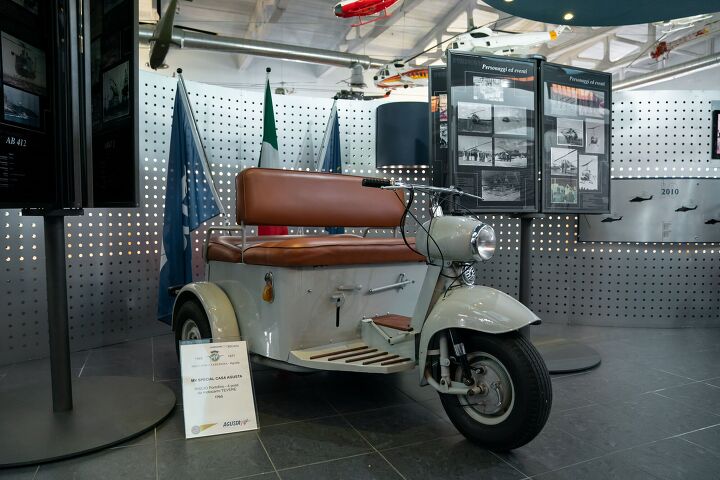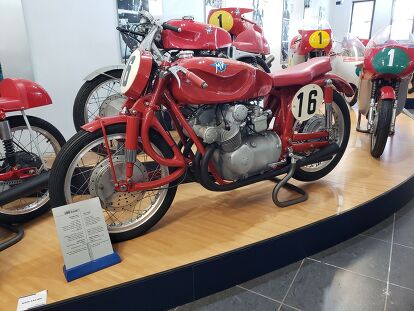A Visit With Champions: Touring the MV Agusta Museum

MV Agusta’s rich history is more than just motorcycles – there are helicopters, too!
Riding through the little village of Samarate in Varese, Italy, the roads are narrow, with flats adorning one side – usually two or three stories high – and fields and trees adorning the other. Cars parked along the road make the narrow street even tighter, and the foot traffic marching to the church can clog the streets on a Sunday. It’s a sleepy little town and is remarkably easy to miss. You can ride right on through, from one end to the other, and dismiss the town entirely. Except for the little house with a helicopter – four, actually – resting on the lawn under canvas tarps. They’re so out of place in this little town that it’s hard not to stop and wonder what they’re doing there. That’s when you realize you’ve reached the Museo Agusta, or the MV Agusta museum.
Fans and enthusiasts obviously recognize the MV Agusta name for its creations on two wheels, but the Agusta namesake first made itself known in the world of aeronautics and helicopters. Dating back to its first flight in 1907, air travel was the Agusta family’s first love, and its contributions to the aerospace industry continues to this day. The second world war disrupted the Agusta family’s flight ambitions, and immediately after the war, it turned to motorcycles as a means of mobilizing Italians (not unlike its neighbors in Bologna…). This 30-year period from 1946 to 1976 would prove fruitful for MV Agusta, as it won countless races, regional championships, and of course, 37 world championships before shutting its doors in 1977.
The Museo Agusta is the haven for which some of the most important and significant MV Agusta artifacts are housed, from both the motorcycle and aeronautics divisions. And speaking of housing, the accompanying Agusta Museum Foundation is the actual home the Agusta family lived in and was fully renovated and refurbished back to its 1935 status. This is where the corporate archives of the company are stored and displayed, located just steps away from the Museo Agusta. If you’re an aviation enthusiast, you’ll find over 75,000 slides, 20,000 drawings, and over 1,400 volumes, including books and magazines from 1900-1940. There’s even a Chinese publication dating back to 1890!
Though the original furniture from 1935 has been lost to time, the restoration captures the essence of the era, and save for the kitchen, which is now used as an archive, the rest of the home is like walking into a time capsule. Unfortunately, we didn’t get the chance to venture over to the old Agusta home.
Recently however, Motorcycle.com had the opportunity to tour the Museo Agusta. And while we, like many of you, enjoy the wonders of flight, we kept our focus on the legendary motorcycles within the museum. There were far too many artifacts to capture it all, but these were some of the highlights of our trip.
This odd duck above is a 1951 500 Corsa. Powered by a 500cc four-cylinder four-stroke with two gear-driven overhead cams, it made 51.5 horsepower at 9,000 rpm. More interesting than that is the clever engineering for the time. The cutouts along both sides of the fuel tank allow for the steering sweep of the bars, while also allowing the rider to place their arms there while in a tuck. The cutouts closest to the seat keep the rider’s knees tucked away and out of the wind, too. If you look at the front suspension, you’ll see MV Agusta was already experimenting with alternatives to the conventional telescopic fork. This linkage-type front suspension is similar to other linkage designs like the Hossack or BMW’s telelever in that the design separates braking force from suspension force, allowing the wheelbase and front end geometry to remain fairly consistent.
Above are two very significant MV Agustas, in a room filled with them. The 500cc four-cylinder in the foreground is the last Grand Prix race bike MV Agusta produced in 1976 before taking a 15-year hiatus starting the following year. Behind it is a 750S America – but this isn’t just any 750S America. The 750S America was MV’s last road model produced before it shut down, and this one comes courtesy of Seiji Fukuda of Japan. Fukuda-san was the sole Japanese importer of Magni motorcycles, which itself was founded by Arturo Magni, historic director of the MV Agusta racing department. Fukuda and Magni became good friends and Fukuda-san asked Magni to find a significant MV Agusta to add to his personal collection, and Magni immediately suggested this 750S America and personally took it upon himself to complete the restoration back to its original condition, even signing it to prove his dedication. In 2023, after three decades in his collection, Fukuda-san has donated his 750S America back to the MV Agusta museum, returning it home.
In the above photo, tucked away in the far depths of the museum, are these oddities. Starting on the left is an experimental prototype car from 1951, one of only two ever made. Powered by a 350cc twin-cylinder four-stroke, the engine is in the rear and drives the rear wheels, which are suspended on independent A-arms – something mainstream cars wouldn’t adopt for years. In the middle is an MV Agusta garden tiller, and on the right in white is an “overcraft” from 1969, powered by a 300cc twin-cylinder two-stroke and built in collaboration with Bell-Aircraft, in which MV Agusta partnered with for helicopter production. Less than 10 were ever produced.
Become a Motorcycle.com insider. Get the latest motorcycle news first by subscribing to our newsletter here.

Troy's been riding motorcycles and writing about them since 2006, getting his start at Rider Magazine. From there, he moved to Sport Rider Magazine before finally landing at Motorcycle.com in 2011. A lifelong gearhead who didn't fully immerse himself in motorcycles until his teenage years, Troy's interests have always been in technology, performance, and going fast. Naturally, racing was the perfect avenue to combine all three. Troy has been racing nearly as long as he's been riding and has competed at the AMA national level. He's also won multiple club races throughout the country, culminating in a Utah Sport Bike Association championship in 2011. He has been invited as a guest instructor for the Yamaha Champions Riding School, and when he's not out riding, he's either wrenching on bikes or watching MotoGP.
More by Troy Siahaan













































Comments
Join the conversation
I agree with SRMark that would make a bucket list visit. But if you can't make it to Italy, I remember that Barber had some nice racing MVs on display. My visit was a long while so, but they might have some still.
Being raised in throughout the 50',60' and then into the 70's I read all of the motorcycle weekly papers that my father would bring home, and was always a big fan of the MV's and of course all of the legendary riders. I never did make it over to the Isle of Man TT races - my father couldn't afford it. However he did make up for it by making sure we attended many of the short circuit races at home in the U.K. Eventually getting into the pit area's and obtaining Ago's autograph and standing around to watch and hear Magni warm up the MV's is a memory that will stay with me forever. Now approaching 70 and far away from Europe visiting the MV museum ( or Agostini's personal collection will never materialize.. Thank you so much for this article, the write up along with the fantastic photography was well appreciated ..